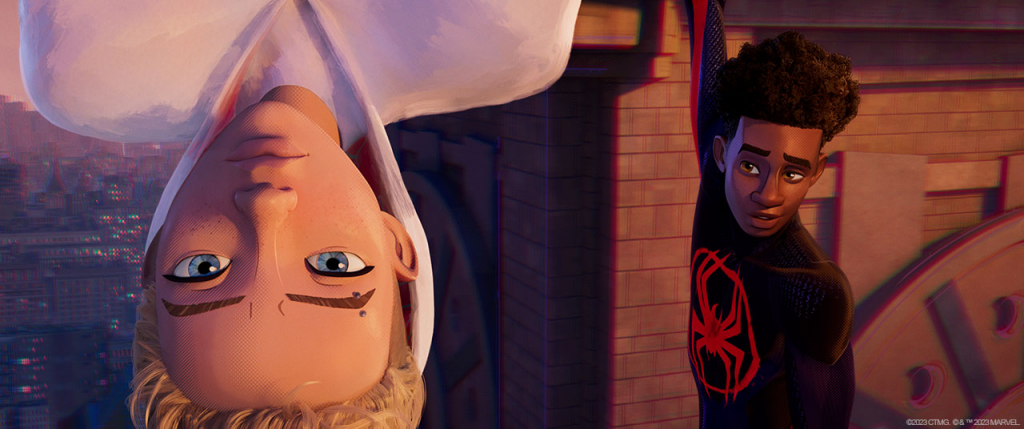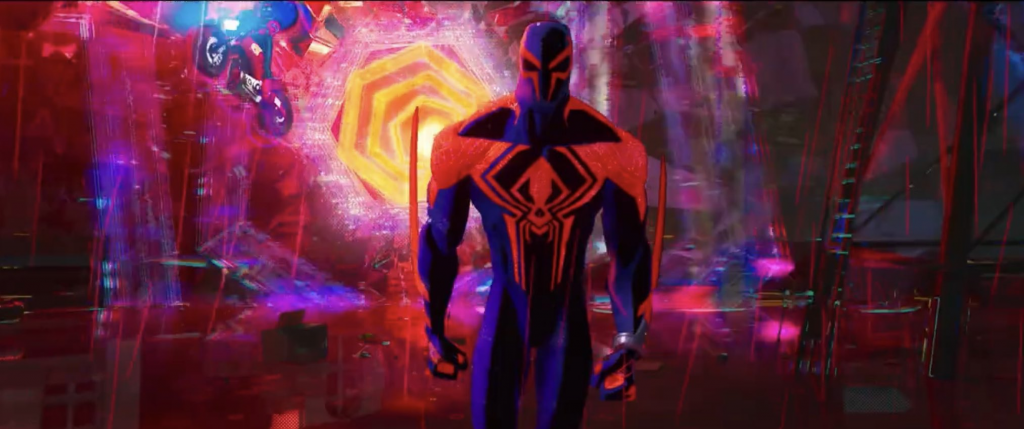Heart and Style: What Makes “Spider-Man: Across the Spider-Verse” Such a Cinematic Achievement

Warning: this article contains spoilers
In December 2018 Into the Spider-Verse released in theaters and forever changed the landscape of animated movies and the way general audiences saw Spider-Man with the introduction of legacy hero Miles Morales. The film’s unique handling of animation in addition to a gripping, well-written narrative and strong characterization throughout solidified it as a fan favorite over the years since its release. As such, Across the Spider-Verse had a lot to live up to as a sequel to such a beloved film, and it massively succeeded by expanding on every aspect that made the first Spider-Verse film so beloved. Across the Spider-Verse doesn’t just succeed as a sequel—it continues the previous movie’s trend of pushing the boundaries of animation and celebrating the core traits of Spider-Man that fans and general audiences alike have grown to love.
Animation

Animation is at the heart of what makes Across the Spider-Verse stand out so boldly in other films of the medium. Into the Spider-Verse was able to blend several different styles to represent the different Spider-personas that come to Miles’ earth, and this sequel expands on the unique, distinctive ways in which these larger-than-life characters can be animated. From the overly-inked 90s comic book design of the edgy Ben Reilly/Scarlet Spider, to the Lovecraftian image of the Spot’s imposing final form, Across the Spider-Verse captures who its characters really are at their core through visual depiction. Easily the most excellently implemented character style was that of Hobie Brown/Spider-Punk, whose anarchic character is perfectly represented in an ever-shifting animation of magazine/paper cutouts.
The film further explores the possibilities of animation by changing the style of other earths to match their respective heroes. For instance, Pavitr Prabhakar’s Mumbhattan and Miguel O’Hara’s Nueva York, two of the prominent earths to feature in the movie, carry such different tones to them. As producer Christopher Miller explained to Empire, the goal was to pay homage to various art styles of the past to reflect the different kinds of stories these characters come from—placing the viewer in different worlds not just by telling them, but by showing it stylistically, and quite effectively at that. The most ambitious and impactful style used for an earth in the film is that of Spider-Gwen on Earth-65, in which the characters and world are captured in pastel paint. Throughout the scenes on Gwen’s earth, the painted background is constantly shifting to symbolize her emotions, making every shot look like literal artwork. There is so much abstraction in the scenes on this earth that elevate already tense emotional moments—a feat that could only be so finely accomplished with animation.
A Human Story

The best Spider-Man stories tend to be focused not so much on the fantastical, but rather the personal life of the hero—a sentiment that Across the Spider-Verse handles beautifully. While the multiverse superhero hijinks are the major draw, the film’s story actually has a lot of heart. The emphasis on family dynamics seen in the first film returns, as Miles internally struggles with whether or not to open up to his parents about being Spider-Man. It’s something everyone can relate to—minus, of course, the superhero aspect. Every kid, like Miles, has had moments growing up when they were uncertain about how vulnerable they could be with their parents, and every parent, like Rio and Jefferson, has to eventually deal with their son or daughter growing up and doing their own thing. The movie does an excellent job showing both sides of this common family struggle while conveying that, at its core, the love is still there—even if there is some distance and things left unsaid.
Gwen is as much of the main character as Miles this time around, and her story echoes a lot of the same sentiments with familial dynamics. Gwen’s secret, however, is much more tragic, as her father blames her alter ego for Peter’s death. Throughout the early moments of the film, Gwen struggles with the burden of this secret; a combination of guilt for not being able to save her best friend and fear of what her father will say or do if he ever finds out who she is. It’s a profound allegory for any big secret a son or daughter keeps from their parents—the weight of something significant being suppressed combined with the scary uncertainty of what happens when the truth comes out. Using the Spider-persona as a springboard, both of these characters’ personal struggles are at the forefront, telling a very human, relatable story about growing up and finding an identity.

A romance between Miles and Gwen is also hinted at in the film and is dealt with just the right amount of tact. Both of them, as young superheroes, are struggling with balancing their superhero selves with their personal lives, and as such they both carry a similar sense of loneliness as neither can reveal who they are entirely to their loved ones. Miles and Gwen, through this shared sense of isolation, find happiness in being with each other—when they can be their honest and complete selves. It’s a great way to not just set up a potential romance between the two, but to also give them each an outlet as individual characters who share a common inner conflict. It also helps that Shameik Moore’s and Hailee Steinfeld’s performances masterfully embody their respective characters, capturing a stellar chemistry between the two.
Ultimately, the film’s main conflict leans into a very personal goal—Miles’ determination to save his father. Among the anomalies with the potential to tear apart the multiverse, the real stakes for Miles are simply losing someone he loves. In a genre bloated with end-of-the-world threats, Across the Spider-Verse deals with something much more resonant: the fear of losing someone close to you. With this conflict, Miles’ story takes on so much more heart than a lot of other superhero narratives. Across the Spider-Verse manages to stand out so distinctly in the comic book film genre because, at its core, the film’s narrative is so personal and less reliant on generic world-ending tropes seen in plenty of other Marvel properties.
Music and Soundtrack

Across the Spider-Verse‘s powerful narrative is only enhanced by a strong soundtrack that, like the varying animation styles, captures the essence of various Spider-personas. Gwen’s theme starts as one of melancholy, reflective of her inner guilt over Peter’s death and the secret kept from her dad, but it then shifts to an upbeat, adventurous tone that speaks to her confidence as Spider-Woman and strength that identity offers her. Spider-Man 2099’s theme, reminiscent of the Prowler’s in the previous film, is menacing and ominous, hinting at his role as an antagonist early on in the film—someone mysterious, unknowable, and ultimately a threat. Spider-Man India’s theme even reflects his character, as its light and boisterous tone alludes to his inexperience as Spider-Man; he is too early into his career to have experienced loss and treats his superhero identity lightly. Daniel Pemberton’s work as the film’s composer complements Across the Spider-Verse‘s already strong characterization and does a significant job of bringing the feelings of characters and scenes to the forefront.
The Metro Boomin-produced album for the film is full of songs that elevate the emotional resonance of several scenes. “Self-Love” from Coi Leray, for instance, is the first song on the album to appear in the film as Gwen reflects on her past and Peter’s death, adding a somber sense of angst and heartbreak to the scene while conveying Gwen’s loneliness. Dominic Fike’s lighthearted “Mona Lisa” plays over one of Miles and Gwen’s first scenes together as they swing through Brooklyn, emphasizing the young love between them and the happiness they find in each other as people in similar situations. “Am I Dreaming” from A$AP Rocky and Roisee plays over the credits of the film, playing off the cliffhanger Across the Spider-Verse ends on; despite the Spot, the Spider Society, and the Prowler of Earth-42 all standing in his way, Miles is determined to save his father. As is the case with Pemberton’s score, Across the Spider-Verse‘s album masterfully enhances the film’s strong narrative with every song.
Who is Spider-Man?

Every Spider-Man adaptation has this question at its center, and the answer isn’t always the same for the many writers who have handled the character. Across the Spider-Verse explores two differing views of Spider-Man as a character—the hero who emerges stronger from tragedy and the hero who is determined to do everything in his power to save the ones he loves. The complex beauty of this dichotomy is that there is no right answer, as both tragedy and determination have molded countless versions of Spider-Man. As such, Across the Spider-Verse serves as an analysis of how the Spider-Man character is made and challenges the viewer to question how they define the hero. While the film urges us to take Miles’ side, the audience can understand both his and Miguel’s differing perspectives.
The film’s inclusion of such a broad multiverse of Spider-people is what makes this conflict so interesting, as we can see several other examples of people who lost their own loved ones and have already undergone canon events that solidified them as heroes. There is the sense that loss is a constant for Spider-people across every world, which only escalates the sense of futility in trying to prevent Jefferson’s death. Miles makes the decision to try and save his father anyways, embodying the strong will of Spider-Man while also challenging a trope of the character—loss that always emerges to mold him as a character. It’s a deceptively simple conflict that, when looked at closely, deeply instills questions about how the typical Spider-Man story is told, and by extension whether Miguel or Miles is more in the right.
Heart and Style

What makes Across the Spider-Verse such a great movie comes down to these two aspects: the achievement of not just telling a strong, provocative story, but also presenting it in such a unique, sometimes groundbreaking way. As was the case with its predecessor, Across the Spider-Verse revolutionizes animation with its ambitious techniques of bringing distinct characters and worlds to life. This animation, coupled with a strong album and soundtrack, enhances a complicated yet very relatable story about growing up and defining oneself. Ultimately, the film is a celebration of Spider-Man stories as a whole, making fans question what makes the hero—the tragedy, or the resistance against it—while also capturing the heart of the character: just someone trying to do the right thing.

